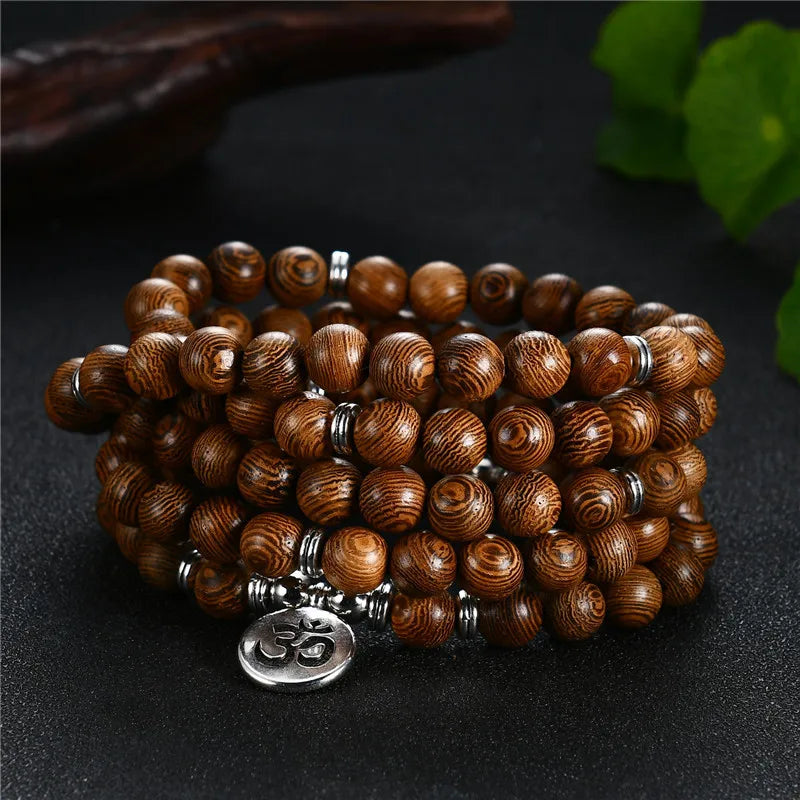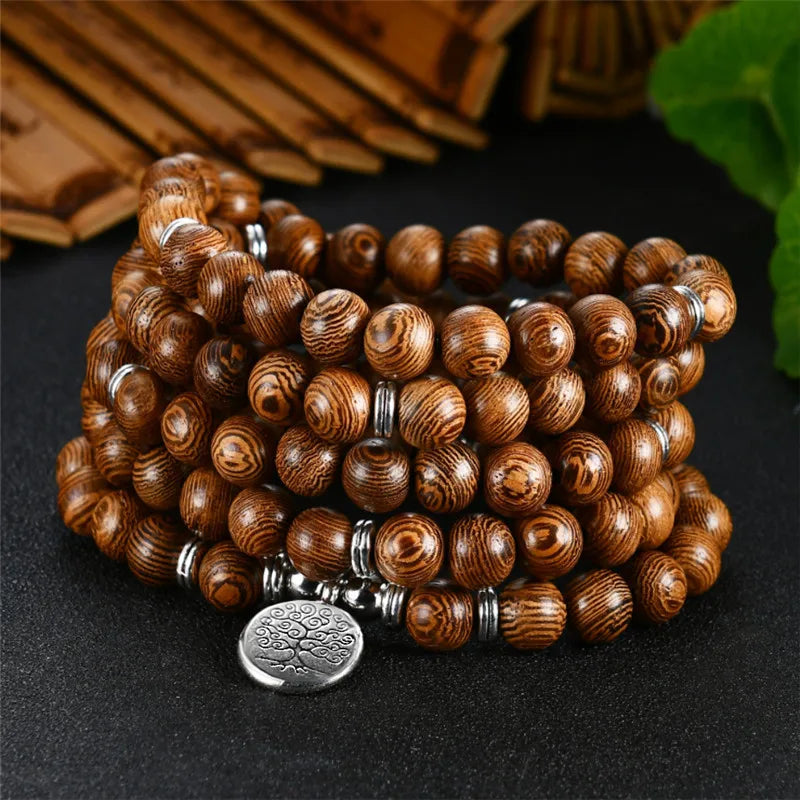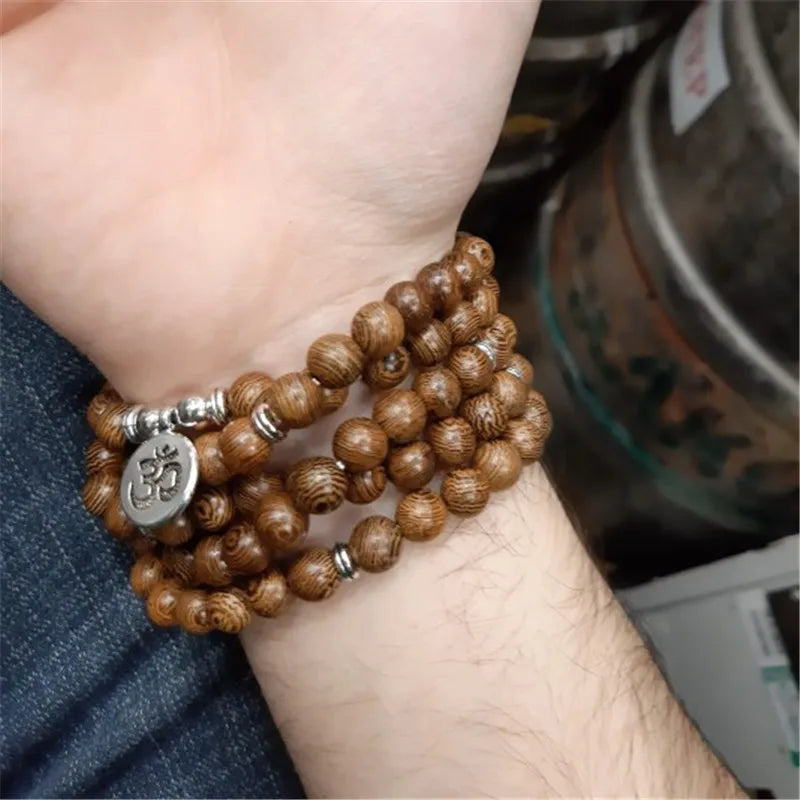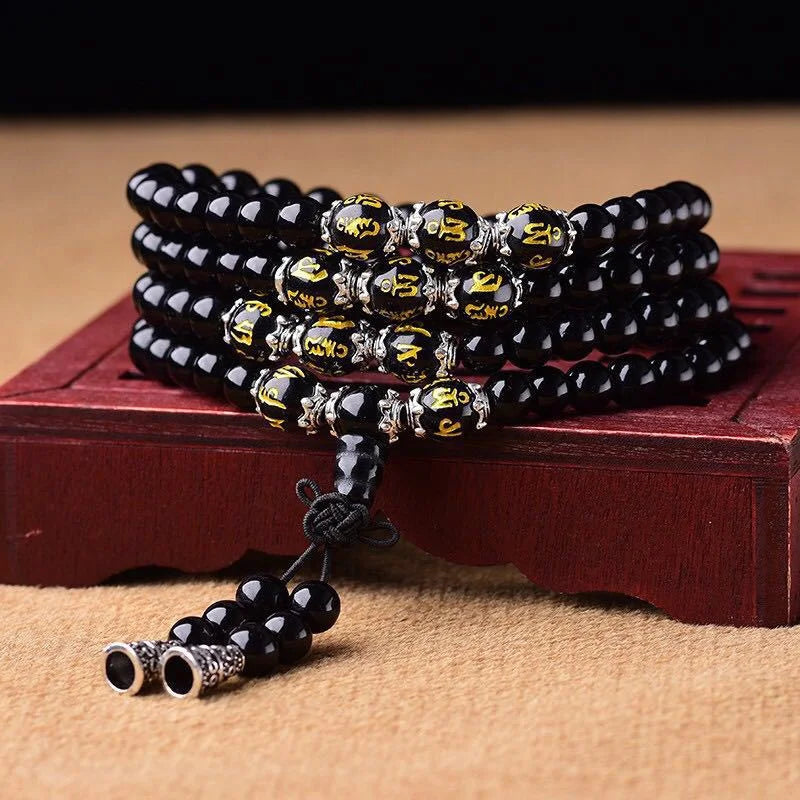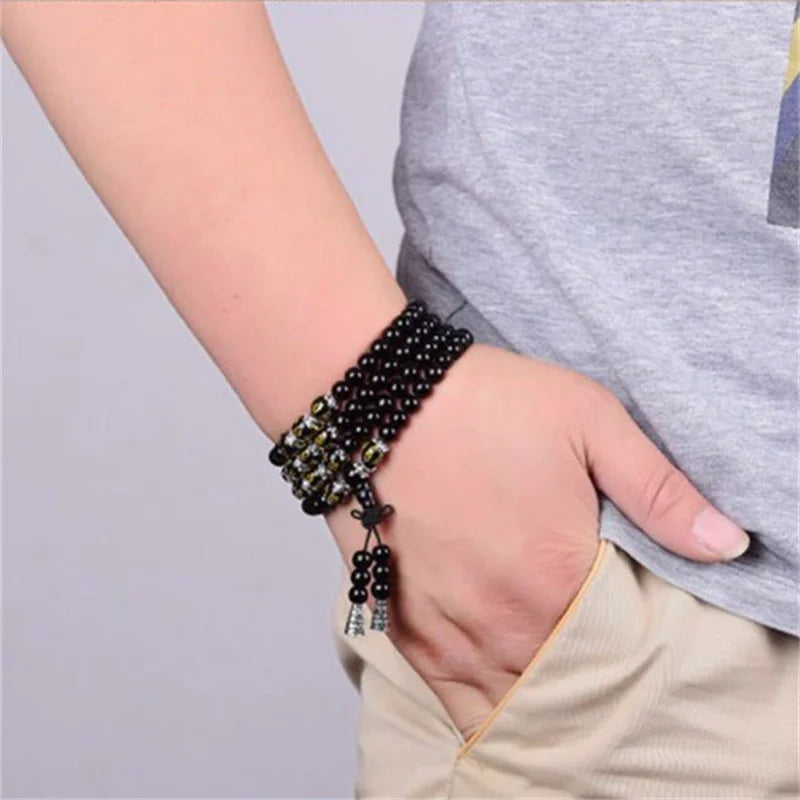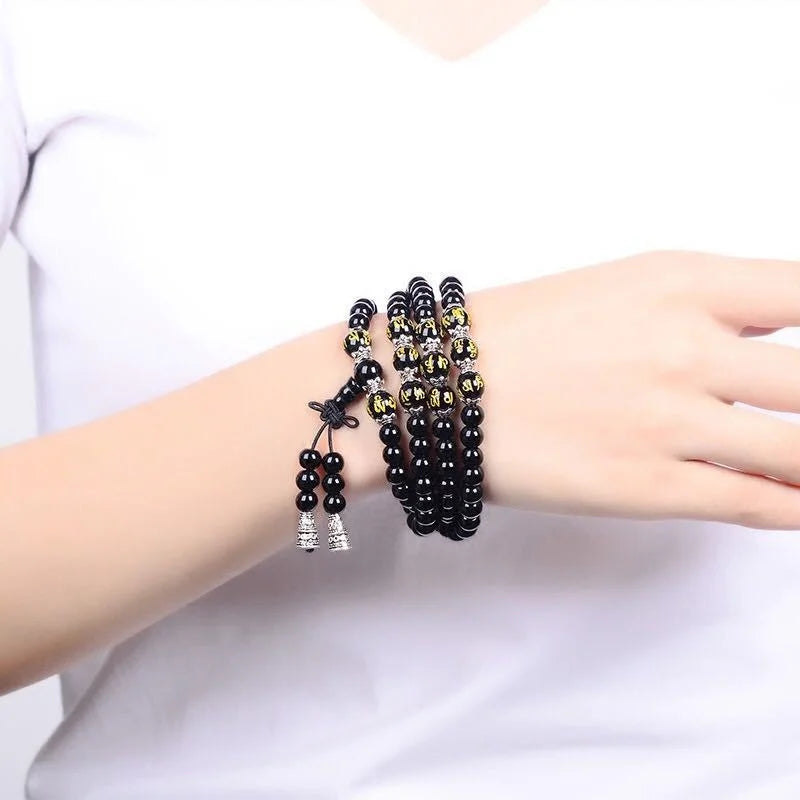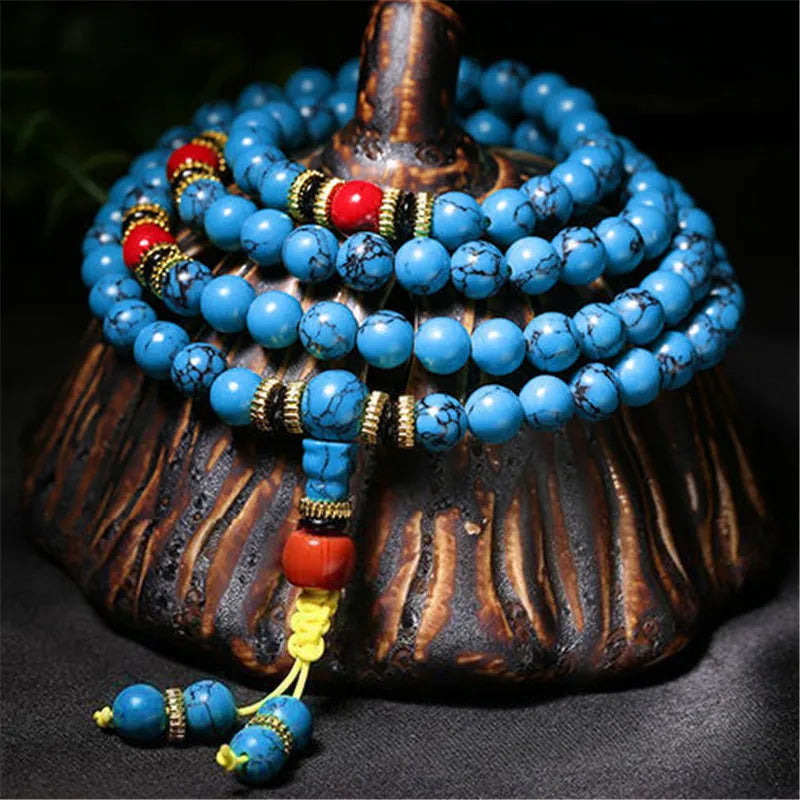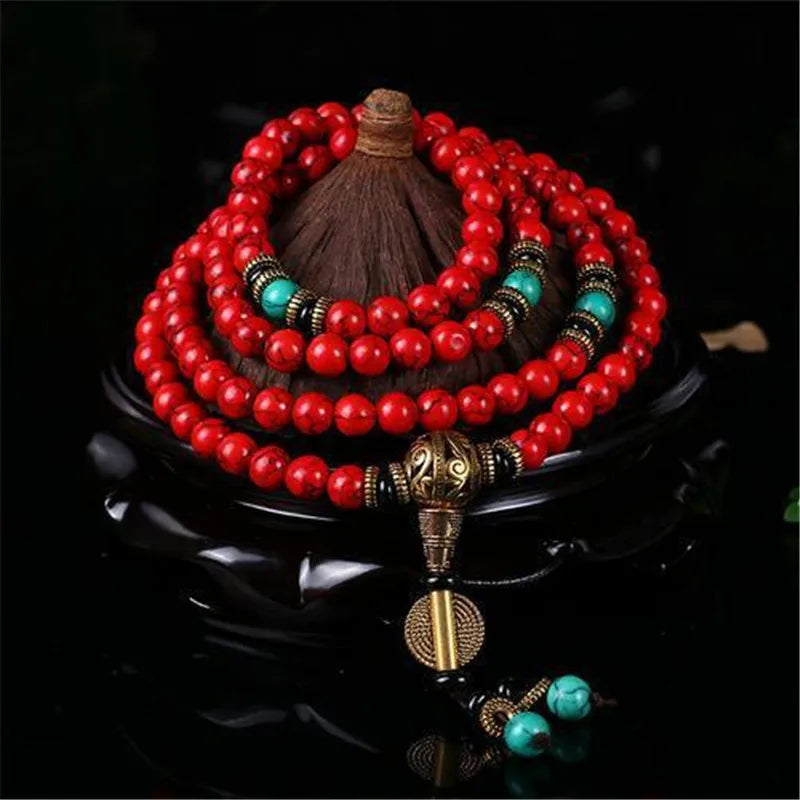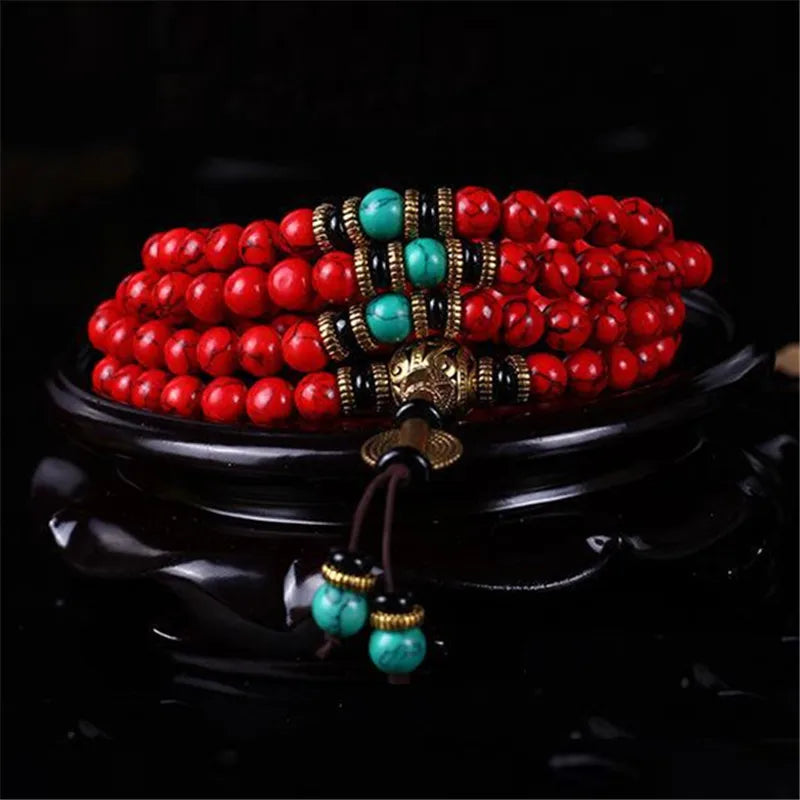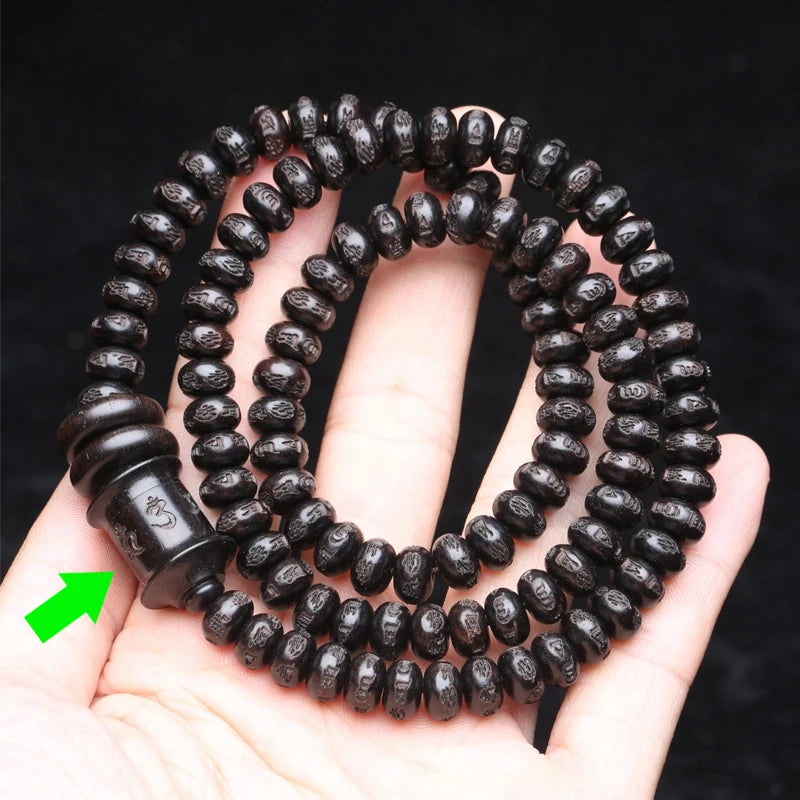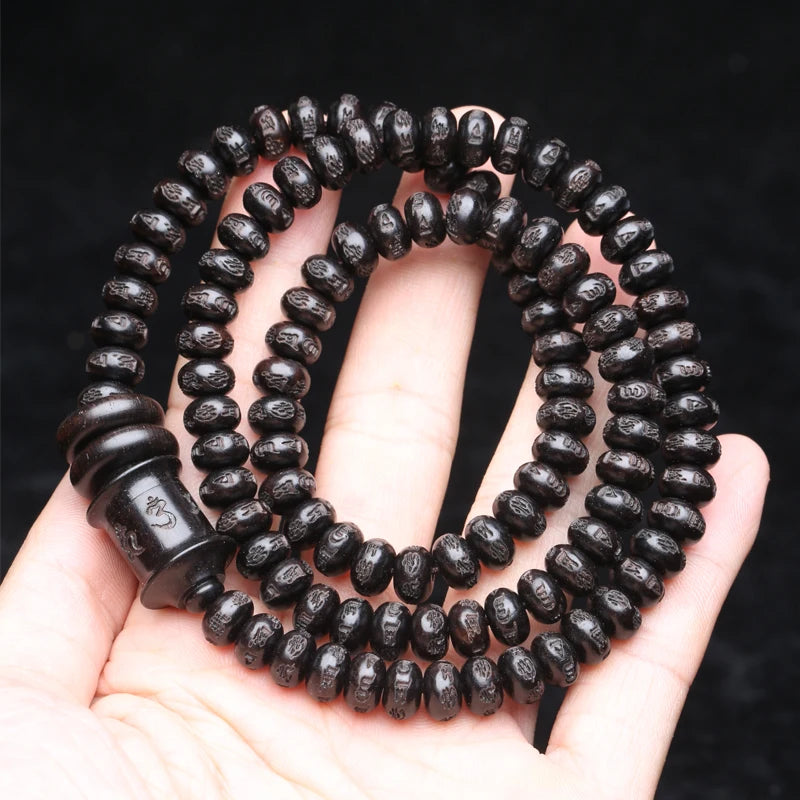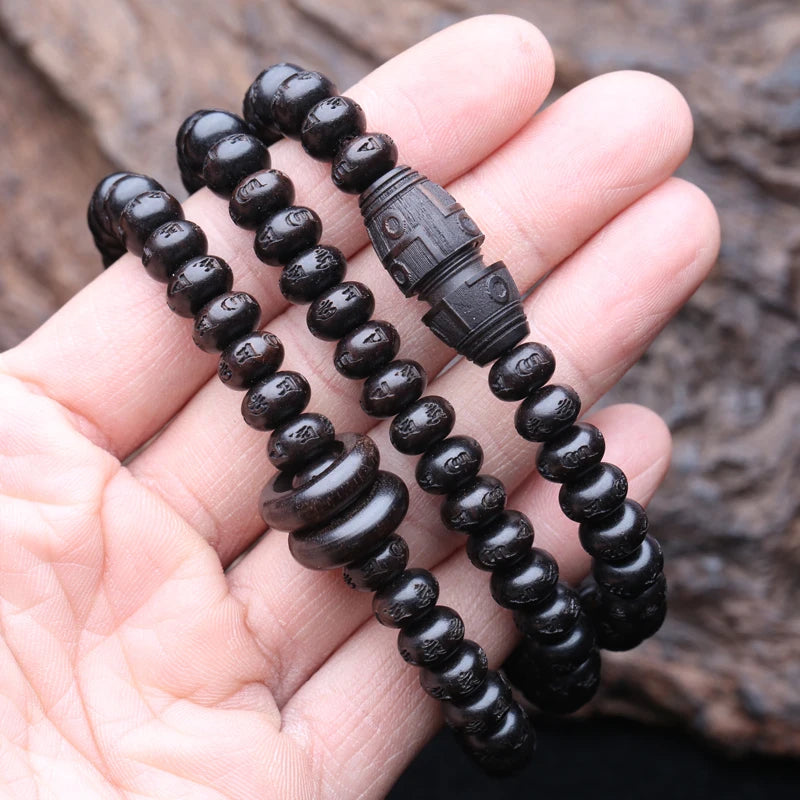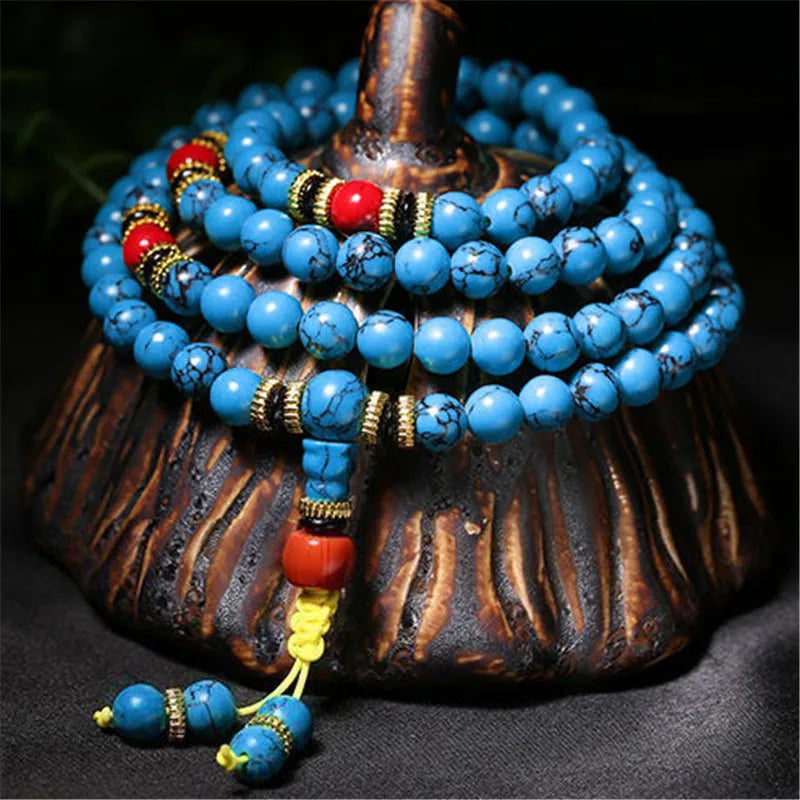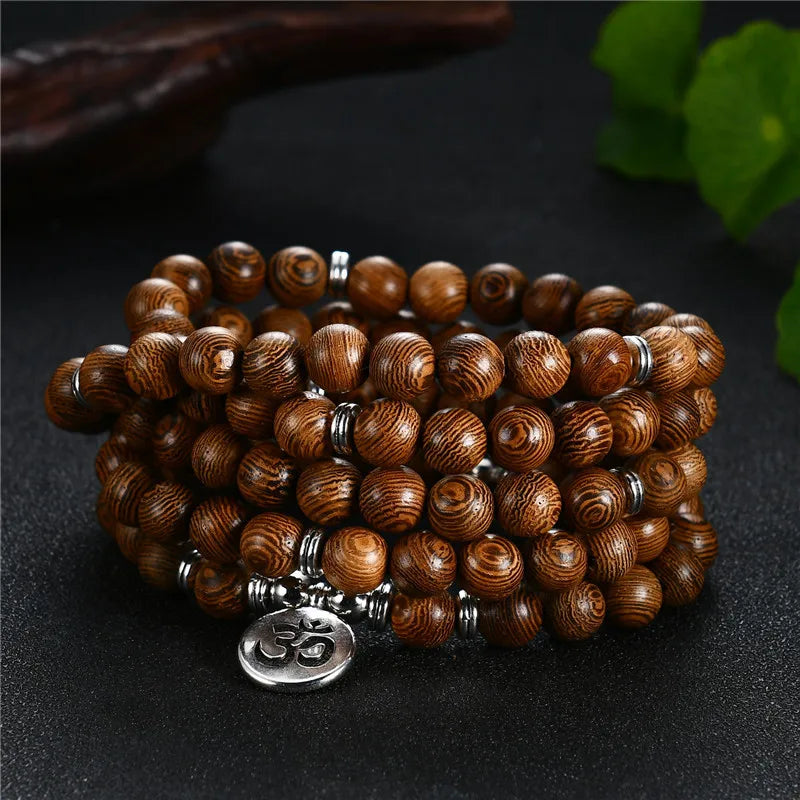並べ替え:
4個の商品
4個の商品
Product Description
Your New Favorite Thing (That Also Happens to Be Ancient)
Tired of your stress having stress? Meet the Mistgift Mala, your 108-bead ticket to inner peace and outer style. This isn't just another piece of jewelry; it's a centuries-old chill pill you can wear. Hand-strung with genuine wood beads, each one carries the warmth of nature and the promise of a quieter mind. Forget fidget spinners; this is the original anxiety-reduction tool used by monks and mindful masters for generations. It feels amazing in your hands, looks incredible around your neck or wrist, and secretly doubles as your personal zen manager. Who says you can’t accessorize your way to enlightenment?
More Uses Than Your Smartphone (But Way Less Annoying)
This magnificent mala is the Swiss Army knife of serenity. Loop it around your neck as a statement wood bead necklace that whispers "I have my life together" (even if you really don't). Wrap it around your wrist as a powerful meditation bracelet to keep the good vibes flowing all day long. Use it for its intended purpose: counting mantras during your meditation practice with its traditional 108 beads. Each bead is a chance to take a breath, focus your intention, and remind yourself that you are a glorious human being, capable of great calm and even greater coffee consumption. It’s a meaningful gift, a spiritual tool, and a fashion-forward accessory all rolled into one beautifully crafted strand.
Crafted by Good Vibes & Excellent Taste
We didn’t just make this; we made it with intention. Sourced from high-quality, natural wood, every bead is smooth to the touch and light on the skin. The classic Tibetan Buddhist charm adds an authentic finishing touch, a little nod to the ancient traditions from which this practice came. This is a durable rosary bracelet and necklace built to withstand daily wear, countless meditation sessions, and the occasional accidental drop into your yoga bag. It’s ethically crafted for the conscious consumer who wants their purchases to have purpose and their style to have soul. This isn’t fast fashion; it’s forever peace.
SPECIFICATIONS
Beads bracelet: Yoga Bracelet
Bracelets Type: Strand Bracelets
Chain Type: Beaded Bracelet
Charm Bracelet: Wood Bracelet
Clasp Type: Toggle-clasps
Gender: Unisex
Material: Wood
Metals Type: Stainless Steel
Natural wood bracelet: Buddha Bracelet
OM Bracelet: 108 Bracelet
Occasion: Anniversary Engagement Gift Party Wedding
Notes
1. For taking the product off:
As our products are made from natural materials, we recommend removing them before sleeping or washing.
2. For measurement deviations:
Please note: The above measurements are taken by hand, so a slight variance is possible.
3. For environmentally friendly materials:
All of our products are crafted from natural, environmentally friendly materials.
4. For handmade and natural variations:
As each item is handmade from natural materials, you may find slight irregularities and unique variations in colour. The image is a representative example, but the actual colour may differ slightly due to lighting and the natural character of the materials.
Product Description
Carry a touch of sacred serenity with this beautifully handcrafted mala, featuring 108 polished obsidian beads engraved with the powerful Tibetan Buddhist mantra, Om Mani Padme Hum. Known as the mantra of compassion, its vibrations are said to bring peace, clarity, and protection to the wearer.
Crafted from genuine obsidian—a stone revered for its grounding and protective properties—this mala is both a spiritual tool and a meaningful accessory. Each bead is carefully strung by hand, finished with an adjustable tassel for versatile wear as a bracelet or necklace.
Ideal for meditation, mindfulness, or daily intention-setting, this piece makes a thoughtful gift for anyone on a path of inner growth, or simply seeking a beautiful reminder of compassion and presence in their day.
Obsidian
Protection | Clarity | Grounding | Release Past Traumas | Calm the Mind | Meditation | Inner Truth
Obsidian is a natural volcanic glass known for its deep black, glossy finish and smooth, sharp texture. Formed from rapidly cooling lava, it’s both elegant and powerful. Wearing obsidian is believed to offer strong protection against negative energy, emotional stress, and psychic attacks. It’s also thought to promote clarity, grounding, and emotional honesty, helping to release past traumas and foster inner strength. Many wear it as a shield during challenging times or as a tool for deeper meditation and self-discovery.
Om Mani Padme Hum
"Om Mani Padme Hum" is a sacred Sanskrit mantra deeply connected to Avalokiteshvara, the Buddhist embodiment of compassion. Reciting this mantra is believed to purify the body and mind, nurture compassion and wisdom, and help transform negative thoughts and actions into positive, enlightened qualities. Each of its six syllables corresponds to a virtue—such as generosity, patience, determination, focus, and wisdom—ultimately symbolizing the inseparable union of wisdom and method needed to attain enlightenment.
SPECIFICATIONS
Bracelets&Bangles: Chakra bracelets
Charms Bracelets: Natural stone necklaces
Clasp Type: Toggle-clasps
Gender: Unisex
Material: Stone
Metals Type: Stainless Steel
Obsidian Bracelets: Yoga Bracelets
Occasion: Anniversary Engagement Gift Party Wedding
Rosary Bracelets: Gifts Jewelry
Safety Standards: CE Lead Free Nickel Free
Notes
1. For taking the product off:
As our products are made from natural materials, we recommend removing them before sleeping or washing.
2. For measurement deviations:
Please note: The above measurements are taken by hand, so a slight variance is possible.
3. For environmentally friendly materials:
All of our products are crafted from natural, environmentally friendly materials.
4. For handmade and natural variations:
As each item is handmade from natural materials, you may find slight irregularities and unique variations in colour. The image is a representative example, but the actual colour may differ slightly due to lighting and the natural character of the materials.
Product Description
Embrace mindfulness and style with our exquisite Mistgift Meditation Mala Set, crafted from genuine red turquoise stones and designed for both spiritual practice and everyday wear. This meticulously hand-knotted piece features 108 beads—a sacred number in Buddhist and Hindu traditions, symbolizing the elimination of 108 human烦恼 (afflictions) and promoting inner peace . The deep red hue of turquoise, traditionally associated with vitality, protection, and courage, adds a touch of earthy elegance to your practice .
Key Features:
-
Natural Red Turquoise Beads: Each 6mm bead is carefully selected for its rich color and smooth texture, believed to enhance energy flow and emotional balance .
-
Hand-Knotted Design: Secured with traditional knotting techniques between beads, ensuring durability and symbolizing the interconnectedness of life .
-
Sacred 108 Count: Represents spiritual completeness—ideal for meditation, mantra recitation, or mindful reflection .
-
Elegant Tassel Accent: The soft silk tassel adds a graceful finish, symbolizing enlightenment and serving as a reminder of your intentions .
-
Versatile Wear: Wear it as a multi-wrap bracelet, a single-strand necklace, or carry it as a pocket mala for daily grounding .
Benefits & Symbolism:
Red turquoise is revered for its protective and healing properties, thought to foster courage, emotional stability, and physical vitality . Whether used for meditation, yoga, or as a meaningful accessory, this mala serves as a tool to quiet the mind, reduce stress, and cultivate focus . The 108 beads align with ancient practices aimed at transcending worldly烦恼 and achieving spiritual clarity .
Perfect For:
-
Meditation enthusiasts seeking a tactile focus for mantra repetition.
-
Spiritual seekers desiring a symbol of protection and positive energy.
-
Fashion-forward individuals who value ethically crafted, meaningful jewelry.
-
Gift-givers celebrating milestones like birthdays, graduations, or spiritual journeys.
Handmade with intention, this Mistgift Mala Set merges traditional craftsmanship with modern elegance. Each piece arrives in a gift-ready box, accompanied by a brief guide to mala meditation. Elevate your practice—and your style—with a piece that carries centuries of wisdom.
Note: As a natural stone, variations in color and texture may occur, making each mala uniquely yours.
Turquoise
Protection | Emotional Balance | Encourage Clear and Honest Communication | Good Fortune | Calm the Mind | Meditation | Inner Truth
Turquoise is instantly recognizable for its striking opaque blue-green color, often with unique veining or matrix patterns running through it. This gem has been valued for centuries across cultures for both its beauty and its powerful properties. Wearing turquoise is believed to offer protection, promote emotional balance, and encourage clear, honest communication. It’s also said to attract good fortune and calm the mind, making it a great stone for reducing stress and boosting confidence. Many wear it as a personal talisman for courage, creativity, and a deeper connection to their inner truth.
Malachite
Absorb Negative Energies | Positive Change | New Beginnings | Protection
Malachite is instantly recognizable for its rich, swirling patterns of deep green and forest bands, making each piece completely unique. Known as the "stone of transformation," it’s celebrated for its powerful energy and protective qualities. Wearing malachite is believed to absorb negative energies and emotional pollutants, helping to encourage positive change, personal growth, and risk-taking. It’s also said to enhance emotional resilience, relieve stress, and stimulate creativity. Many wear it as a talisman for protection during travel or transition, making it a bold and supportive stone for those seeking to break old patterns and embrace new beginnings.
Moonstone
New Beginning | Emotional Balance | Inspiration | Hope | Inner Peace
Moonstone is known for its captivating glow, a phenomenon called adularescence, where it seems to shimmer with a soft, internal light like the moon. This gemstone is deeply connected to intuition and inner growth. Wearing it is believed to enhance emotional balance, promote inspiration, and encourage new beginnings. Often called a "stone of hope," it's said to soothe emotional instability and stress, helping you feel more in tune with your natural cycles and instincts. Many wear it to connect with their feminine energy, foster patience, and invite a sense of calm and harmonious flow into their lives.
SPECIFICATIONS
Bracelets&Necklaces: 108 Beads Bracelet
Chain Type: Rope Chain
Chrysocolla bracelets: Stretch bracelets
Clasp Type: Toggle-clasps
Gender: Unisex
Item Type: BRACELETS
Material: Stone
Metals Type: Copper
Setting Type: None
Notes
1. For taking the product off:
As our products are made from natural materials, we recommend removing them before sleeping or washing.
2. For measurement deviations:
Please note: The above measurements are taken by hand, so a slight variance is possible.
3. For environmentally friendly materials:
All of our products are crafted from natural, environmentally friendly materials.
4. For handmade and natural variations:
As each item is handmade from natural materials, you may find slight irregularities and unique variations in colour. The image is a representative example, but the actual colour may differ slightly due to lighting and the natural character of the materials.
Product Description
"Om Mani Padme Hum" is a sacred Sanskrit mantra deeply connected to Avalokiteshvara, the Buddhist embodiment of compassion. Reciting this mantra is believed to purify the body and mind, nurture compassion and wisdom, and help transform negative thoughts and actions into positive, enlightened qualities. Each of its six syllables corresponds to a virtue—such as generosity, patience, determination, focus, and wisdom—ultimately symbolizing the inseparable union of wisdom and method needed to attain enlightenment.
What the Mantra Means
-
OM: Represents the wholeness of existence and the enlightened state—pure in body, speech, and mind.
-
MANI: Means “jewel,” symbolizing compassion and the selfless intention to reach enlightenment.
-
PADME: Means “lotus,” representing wisdom that remains pure and unaffected by life’s challenges, much like a lotus blooming in muddy water.
-
HUM: Embodies the unity of wisdom and compassion—the essential combination for achieving spiritual awakening.
Why People Chant It
-
Purification: Cleanses negative thoughts, words, and actions.
-
Inner Growth: Acts as the essence of Buddhist practice, helping turn negativity into spiritual progress.
-
Meditation Aid: Provides a focal point during meditation, helping calm and center the mind.
-
Compassion: Invokes kindness and caring energy, making it a powerful practice for personal and collective well-being.
How to Practice
You can chant the mantra aloud or silently, often using mala beads to count repetitions—usually 108 times or more. Focusing on the meaning of the words while reciting can deepen its spiritual effect.
Ebony Wood
Protective Energy | Ward off Negativity | Inner Strength | Patience | Mental Clarity | Meditation
Ebony is a dense, luxurious hardwood, renowned for its deep black color and smooth, polished finish that feels substantial to the touch. Wearing ebony is traditionally believed to offer protective energy, helping to ward off negativity and create a sense of grounding and stability. It’s also associated with strength, patience, and mental clarity, making it a meaningful choice for those seeking resilience and focus in their daily lives. Both elegant and empowering, it serves as a timeless symbol of inner strength.
SPECIFICATIONS
Product size: About 5.5mm x8mm 108 beads
Conversion :1 inch = 25.4 millimeters or 1 millimeter = 0.0393 inches
Lettering: ༀ མ ཎ ི པ ད ྨ ེ ཧ ཱ ུ ྃ །
Color: Black, natural
Process: Polishing and carving
Packaging: Gift bag
This is the most revered in Tibetan Buddhism's mantra: ༀ མ ཎ ི པ ད ྨ ེ ཧ ཱ ུ ྃ །
Tibetan Buddhism takes these six characters as Buddhist sutras
This bracelet is made from 100% natural ebony
Ebony: Air dry density 0.9-1.14. (submerged in water)
Notes
1. For taking the product off:
As our products are made from natural materials, we recommend removing them before sleeping or washing.
2. For measurement deviations:
Please note: The above measurements are taken by hand, so a slight variance is possible.
3. For environmentally friendly materials:
All of our products are crafted from natural, environmentally friendly materials.
4. For handmade and natural variations:
As each item is handmade from natural materials, you may find slight irregularities and unique variations in colour. The image is a representative example, but the actual colour may differ slightly due to lighting and the natural character of the materials.
The Tibetan 108 Beads Mala Bracelet: A Guide to Meaning, Use, and Choosing Authentic Pieces
The Tibetan 108 Beads Mala Bracelet: A Guide to Meaning, Use, and Choosing Authentic Pieces
For centuries, the Tibetan 108-bead mala bracelet has been more than just an accessory; it's a tool for meditation, a symbol of spiritual pursuit, and a piece of cultural heritage. Its enduring popularity spans spiritual seekers, wellness enthusiasts, and fashion lovers alike. But what makes this string of beads so special? Let's explore its deep significance, how to use it, and—crucially—how to choose an authentic and safe piece.

The Sacred Significance of 108 Beads
In Tibetan Buddhism and other Eastern traditions, the number 108 holds profound cosmic and spiritual significance . It is not arbitrary. Here’s what it represents:
-
108 Human Afflictions (Kleshas): It symbolizes the 108 negative mental states or earthly desires—like greed, anger, and ignorance—that a practitioner aims to overcome on the path to enlightenment .
-
A Tool for Mantra Recitation: The mala is used to count repetitions of a mantra (a sacred sound or phrase) during meditation. Each of the beads represents one recitation, helping the meditator maintain focus and intentionality without distraction .
-
Cosmic Harmony: Some interpretations link 108 to the structure of the universe: the 12 months multiplied by the 24 solar terms and 72 climatic phases in a year, or the 108 sacred names of the Divine .
Using the mala is therefore a moving meditation, a physical act of cultivating mindfulness, compassion, and inner peace with each bead passed through the fingers.
Common Materials and Their Believed Properties
Tibetan malas are crafted from a variety of natural materials, each believed to carry its own unique energy and benefits:
| Material | Key Properties & Beliefs | Visual Characteristics |
|---|---|---|
| Amethyst | Calming, enhances intuition and spiritual awareness, promotes emotional balance. | Ranges from pale lavender to deep purple. |
| Turquoise | Protection, vitality, courage, and healing. Highly valued in Tibetan culture. | Opaque blue-green, often with unique veining (matrix). |
| Malachite | Transformation, absorption of negative energy, and emotional healing. | Striking bands of deep green and forest green. |
| Lava Stone | Grounding, calming, and strength. Known for its porous nature, allowing it to absorb and slowly release essential oils. | Matte black, lightweight, and porous. |
| Onyx | Protection, emotional strength, self-control, and grounding during challenging times. | Deep, solid black with a smooth, polished finish. |
| Rose Quartz | Unconditional love, compassion, emotional healing, and harmony in relationships. | Soft, gentle pink color. |
| Moonstone | Intuition, inner growth, new beginnings, and emotional balance. Known for its adularescence (soft, internal glow). | Often milky or translucent with a bluish or white sheen. |
| Bodhi Seeds | Spiritual awakening and wisdom (from the Buddha's tree). | Natural, textured brown seeds. |
Many authentic malas combine several stones or feature a guru bead—a larger, often more ornate bead that marks the beginning and end of the mala cycle and symbolizes the teacher-student relationship.
How to Use Your Mala Bracelet in Meditation
Using a mala is simple but intentional:
-
Set an Intention: Before you begin, hold the mala and set a purpose—whether it’s peace, healing, gratitude, or clarity.
-
Start at the Guru Bead: Begin with the first bead next to the guru bead.
-
Recite and Breathe: With each bead, gently pull it toward you as you recite your chosen mantra (e.g., "Om Mani Padme Hum") or a positive affirmation. Sync this with your breath.
-
Complete the Cycle: After 108 beads, you’ve completed one round. Avoid crossing the guru bead; instead, turn the mala around and continue in the reverse direction as a sign of respect.
You can also wear it daily as a reminder of your intention and a touchstone for calm throughout the day.

A Crucial Buyer's Guide: Avoiding Fakes and Health Risks
The growing popularity of malas has, unfortunately, led to a market flooded with inauthentic, chemically treated, or even hazardous products . Here’s how to choose wisely and safely:
-
Beware of "Too Perfect" Stones: Natural stones have variations in color, slight imperfections, or inclusions. Be wary of beads that look unnaturally uniform or bright, as they may be dyed or plastic imitations . For example, some "turquoise" is actually howlite dyed blue.
-
The Radiation and Toxicity Risk: Shockingly, some stones marketed as "healing" or "energy" stones have been found to be radioactive (e.g., certain "energy stones" containing thorium) . Others, like dyed malachite or treated metals, can leach heavy metals like lead, nickel, or arsenic through skin contact or if accidentally mouthed .
-
Seek Reputable Sellers: Purchase from trusted, transparent sellers who can provide information on the stone's origin. Always ask for a CMA-certified gemological or radioactivity report for higher-priced items, especially if buying online .
-
Trust Your Senses: Authentic stone and wood should feel cool and substantial to the touch, not light or plasticky. The finish should be smooth, and the stringing should be secure with well-finished holes.
Prioritize your health. If a deal seems too good to be true, it probably is. Investing in a genuine, high-quality mala from a reputable source is safer and more meaningful.
Cultural Respect and Practical Care
-
Is it okay to wear it as a necklace? While a full 108-bead mala is traditionally held in the hands or wrapped around the wrist, wearing it as a necklace is common practice in the West. However, some strict traditionalists believe that unless you are an ordained monk, it should not be worn around the neck as a mere fashion statement . The most important factor is the respect and intention with which you treat the object.
-
Caring for Your Mala:
-
Keep It Dry & Clean: Avoid contact with water, perfumes, lotions, and chemicals, which can damage the stones and the string .
-
Store Gently: Keep it in a soft pouch or box to prevent scratches and damage .
-
Cleanse Energetically: Many choose to cleanse their mala's energy by leaving it in moonlight, passing it through sage smoke, or placing it on a selenite plate.
-
Frequently Asked Questions
Q: Can anyone use a mala, even if they're not Buddhist?
A: Absolutely. While rooted in Buddhist and Hindu traditions, people of all faiths and backgrounds use malas as a tool for mindfulness, meditation, and personal intention-setting.
Q: How do I know which stone is right for me?
A: Let your intuition guide you. Often, you'll be drawn to the color or energy of a stone that aligns with what you need most—be it calm (amethyst), love (rose quartz), or protection (black onyx).
Q: My mala broke. What does that mean?
A: In spiritual circles, a broken mala is sometimes said to signify that it has absorbed a great deal of negative energy or completed its purpose for you. Practically, it's often just wear and tear on the string! Take it as an opportunity to re-string it with a new intention.
In Conclusion
The Tibetan 108-bead mala bracelet is a beautiful synthesis of art, nature, and spirit. It serves as a portable anchor to the present moment, a symbol of a mindful journey, and a wearable piece of an ancient cultural practice. Whether you use it for meditation, wear it for its beauty, or cherish it for its meaning, choosing an authentic piece with respect and awareness will make your experience all the more powerful. Let each bead be a step toward greater peace and self-understanding.


